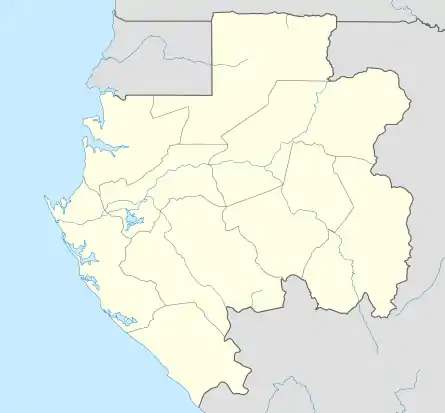Lébamba | |
|---|---|
Town | |
 Lébamba Location in Gabon | |
| Coordinates: 2°12′S 11°30′E / 2.200°S 11.500°E | |
| Country | |
| Province | Ngounié Province |
| Department | Louetsi-Wano Department |
Lébamba is a small town in south-western Gabon. It is the capital of Louetsi-Wano Department in Ngounié Province. It lies along the N6 road, 38.3 kilometres northeast of Ndendé.[1][2] A Catholic Mission has long been established in Lébamba.
Geography
Lébamba is located in south-western Gabon, and in the southeast of Ngounié Province. Kanda and Moukoundou lie nearby to the northeast. The Ngounié River flows just to the west of the town and the Louetsi River is also nearby.[3] The land between Lébamba and Mouila is mainly floodplain.[4][5]
Two kilometres from Lébamba are "massive underground cave networks", known as the Bongolo Caves or Malibé Caves.[1][6] The caves lie at an altitude of 1150 metres.[7] The Lekindou waterfall is also nearby.
Economy
An agronomical research center was established at Lébamba in the 1960s.[8] Since, the Lébamba Agro-pastoral Project has conducted studies on the socio-economic aspects of livestock production in the region.[9] In the 1970s, an oil mill for processing palm oil was established in Lébamba by the Agro-Gabon Company.[10] In 1981, a two-year, UNDP funded project, Agro-pastoral Development of Lébamba Zone, was developed to study the socio-economic aspects of livestock production in the region.[11] In the same decade, rice based farming systems were established in three villages of the Lébamba region.[12] In 1990, it was noted that a soil conditioner project in Lébamba would continue for a few years as the country's soil has fairly low agricultural fertility.[13]
Culture
The Nzebi people (or Banzebi, or Ndzebi)) live in the area between Lébamba and extending to west of Franceville. Njebi, a Northwest Bantu language, is spoken in Lébamba. The Wumbvu people live in the same province, but to the east of Lébamba; they speak the Wumbvu language and are of a different tribal cluster, that of the Central Congo.[14]
It was reported in 1971 that the Christian and Missionary Alliance opened a bookstore, reading room and youth center in the village.[15] The Bongolo Hospital, which is considered to be one of the best in Gabon, is located in Lébamba. Established in 1977,[16] the hospital is staffed by American missionary doctors and is one of only three hospitals in Gabon that offers HIV testing (the others are the Libreville and Port Gentil Hospitals).
Transportation
In 1993, a bridge financed by the US, Canada and France was announced costing CFA69.280m for construction over the Louetsi River near Lébamba;[17] the total cost of the scheme was estimated at CFA281.745m.[17] The Ndende to Lébamba road was constructed with the assistance of China.[18] An 800 metres (2,600 ft) laterite and grass airstrip services the hospital.
References
- 1 2 Auzias, Dominique; Voisin, Bernadette; Labourdette, Jean-Paul (30 September 2009). Gabon. Petit Futé. p. 259. ISBN 978-2-7469-2537-3. Retrieved 31 March 2012.
- ↑ Maps (Map). Google Maps.
- ↑ Harvard University. Museum of Comparative Zoology (1975). Bulletin of the Museum of Comparative Zoology. The Museum. p. 277. Retrieved 31 March 2012.
- ↑ Hughes, R. H.; Hughes, J. S. (1992). A Directory of African Wetlands. IUCN. p. 517. ISBN 978-2-88032-949-5. Retrieved 31 March 2012.
- ↑ Courbon, Paul (June 1989). Atlas of the great caves of the world. Cave Books. p. 1150. ISBN 978-0-939748-21-1. Retrieved 31 March 2012.
- ↑ Warne, Sophie (1 November 2003). Gabon, São Tomé and Príncipe. Bradt Travel Guides. p. 118. ISBN 978-1-84162-073-2. Retrieved 31 March 2012.
- ↑ Paul Courbon (June 1989). Atlas of the great caves of the world. Cave Books. p. 32. ISBN 978-0-939748-21-1. Retrieved 31 March 2012.
- ↑ Yates, Douglas Andrew (1996). The rentier state in Africa: oil rent dependency and neocolonialism in the Republic of Gabon. Africa World Press. p. 154. ISBN 978-0-86543-521-6. Retrieved 31 March 2012.
- ↑ Hoste, C. H.; Africa, International Livestock Centre for (1992). Trypanotolerant livestock in west and central Africa: A decade's results. ILRI (aka ILCA and ILRAD). p. 174. ISBN 978-92-9053-261-3. Retrieved 31 March 2012.
- ↑ United States. Joint Publications Research Service (1978). Translations on Sub-Saharan Africa. p. 20. Retrieved 31 March 2012.
- ↑ Hoste, C. H.; International Livestock Centre for Africa (1992). Trypanotolerant livestock in west and central Africa: A decade's results. ILRI (aka ILCA and ILRAD). pp. 29, 176–. ISBN 978-92-9053-261-3. Retrieved 1 April 2012.
- ↑ World food report. Food and Agriculture Organization of the United Nations. 1 January 1986. p. 42. Retrieved 1 April 2012.
- ↑ Commission of the European Communities (1990). The Courier. Commission of the European Communities. pp. 88–89. Retrieved 1 April 2012.
- ↑ "Missionary Atlas Project West Africa Gabon". worldmap.org. pp. 22, 28. Retrieved 2 April 2012.
- ↑ American Council of Voluntary Agencies for Foreign Service (1971). U.S. non-profit organizations in development assistance abroad. Technical Assistance Information Clearing House. p. 523. Retrieved 1 April 2012.
- ↑ deVries, Catherine R.; Price, Raymond R. (29 November 2010). Global surgery and public health: a new paradigm. Jones & Bartlett Publishers. p. 174. ISBN 978-0-7637-8048-7. Retrieved 31 March 2012.
- 1 2 Africa research bulletin: Economic, financial, and technical series. Blackwell. 1993. p. 11260. Retrieved 31 March 2012.
- ↑ Oxford Business Group. The Report: Gabon 2010. Oxford Business Group. pp. 43–. ISBN 978-1-907065-25-5. Retrieved 1 April 2012.
{{cite book}}:|author=has generic name (help)